MSc Management: Knowledge Management and Coca Cola Report
VerifiedAdded on 2021/06/11
|15
|4262
|278
Report
AI Summary
This report presents an analysis of Coca-Cola's knowledge management and information systems, undertaken as part of an MSc Management program. It begins with an introduction to knowledge management and its importance, followed by an overview of Coca-Cola's corporate objectives, business overview, corporate structure, and business model. The report then delves into a SWOT analysis, PESTLE analysis, and Porter's Five Forces analysis to assess the company's internal and external environments. Key aspects of the report include recommending appropriate knowledge management information systems (KIMS) and discussing the key management implementation challenges. The report concludes with a summary of findings and recommendations for improving Coca-Cola's knowledge management practices. The report also includes a declaration of original work, table of contents, and references.
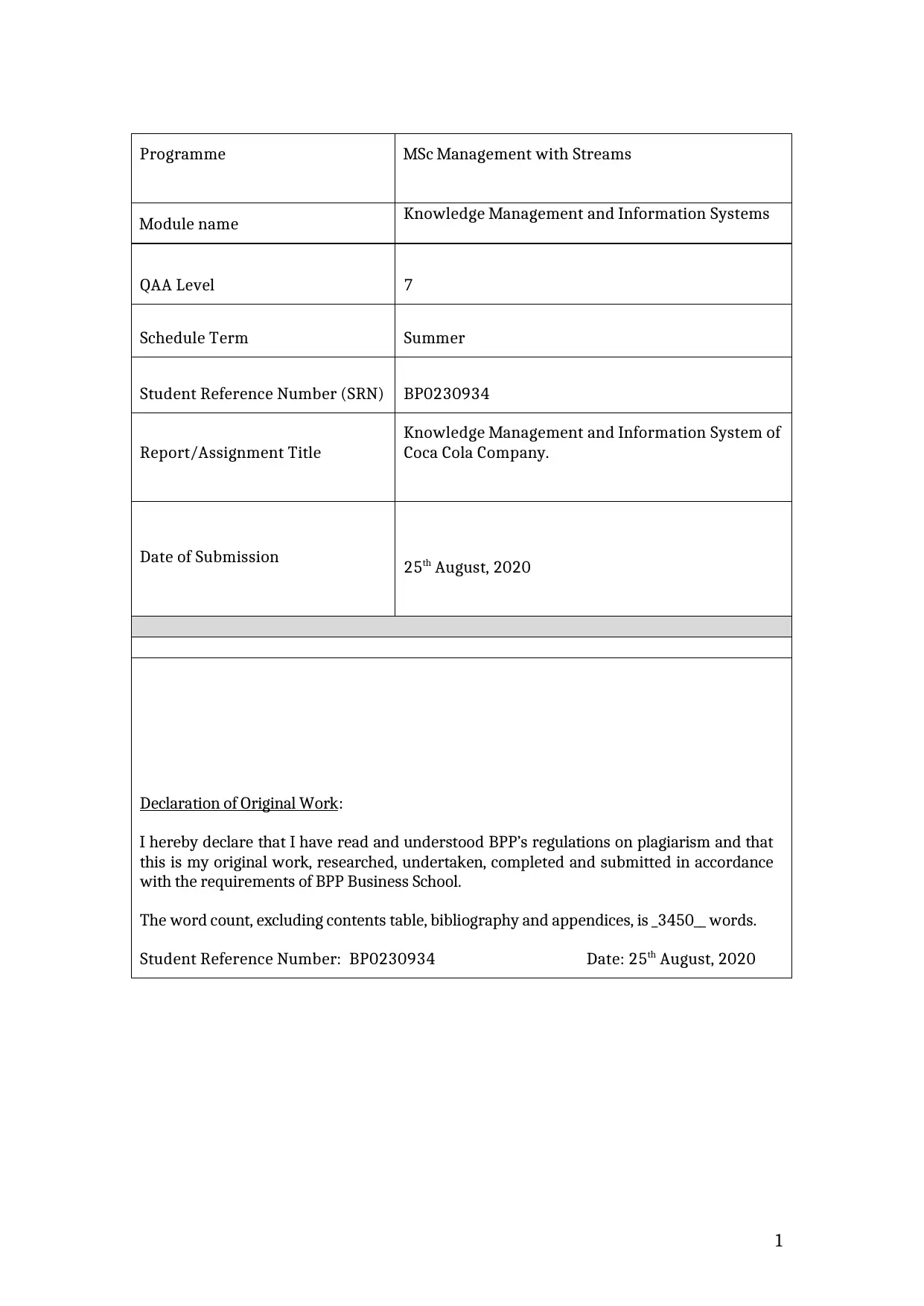
Programme MSc Management with Streams
Module name Knowledge Management and Information Systems
QAA Level 7
Schedule Term Summer
Student Reference Number (SRN) BP0230934
Report/Assignment Title
Knowledge Management and Information System of
Coca Cola Company.
Date of Submission 25th August, 2020
Declaration of Original Work:
I hereby declare that I have read and understood BPP’s regulations on plagiarism and that
this is my original work, researched, undertaken, completed and submitted in accordance
with the requirements of BPP Business School.
The word count, excluding contents table, bibliography and appendices, is _3450__ words.
Student Reference Number: BP0230934 Date: 25th August, 2020
1
Module name Knowledge Management and Information Systems
QAA Level 7
Schedule Term Summer
Student Reference Number (SRN) BP0230934
Report/Assignment Title
Knowledge Management and Information System of
Coca Cola Company.
Date of Submission 25th August, 2020
Declaration of Original Work:
I hereby declare that I have read and understood BPP’s regulations on plagiarism and that
this is my original work, researched, undertaken, completed and submitted in accordance
with the requirements of BPP Business School.
The word count, excluding contents table, bibliography and appendices, is _3450__ words.
Student Reference Number: BP0230934 Date: 25th August, 2020
1
Paraphrase This Document
Need a fresh take? Get an instant paraphrase of this document with our AI Paraphraser
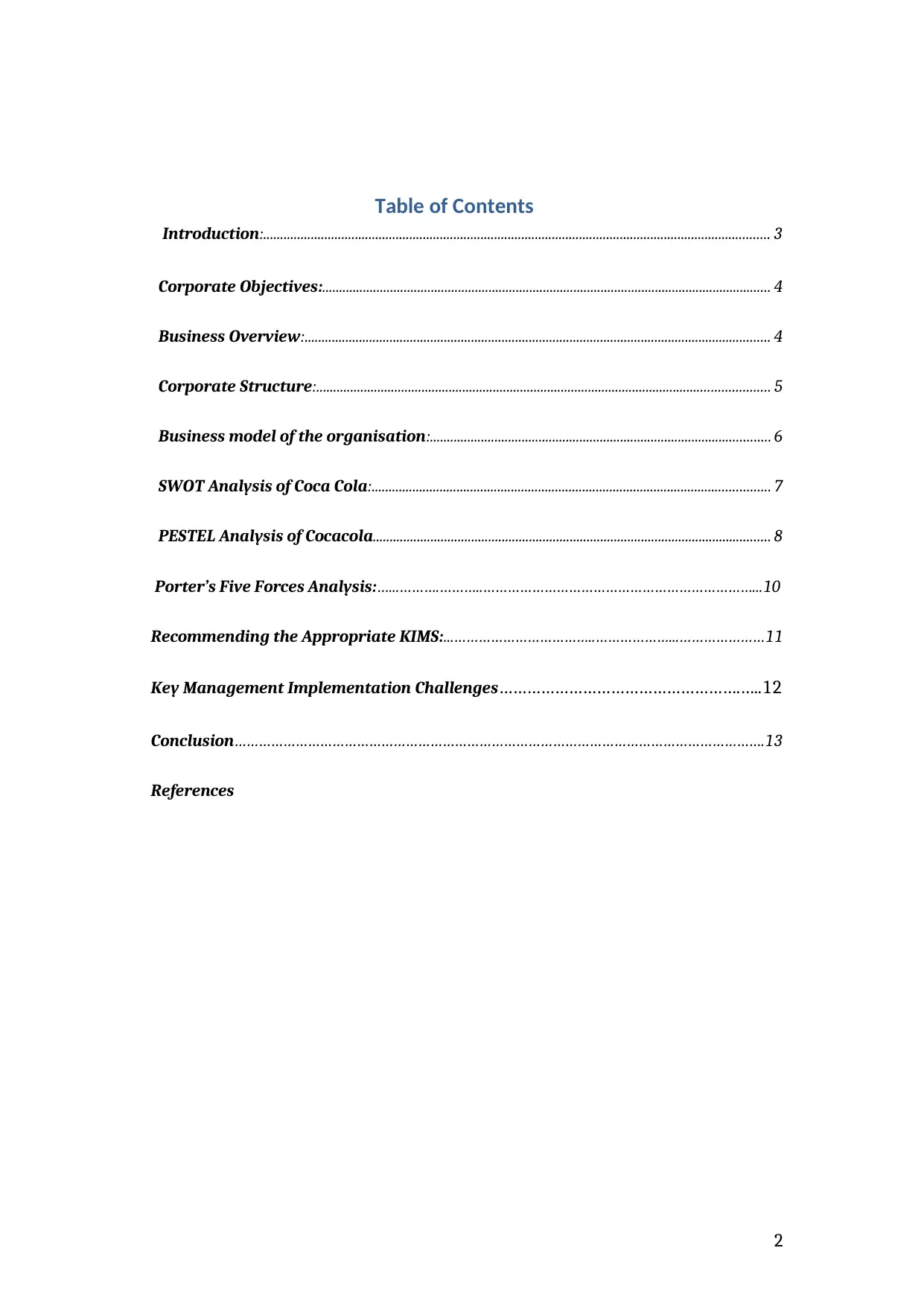
Table of Contents
Introduction:..................................................................................................................................................... 3
Corporate Objectives:.................................................................................................................................... 4
Business Overview:......................................................................................................................................... 4
Corporate Structure:..................................................................................................................................... 5
Business model of the organisation:.................................................................................................... 6
SWOT Analysis of Coca Cola:..................................................................................................................... 7
PESTEL Analysis of Cocacola..................................................................................................................... 8
Porter’s Five Forces Analysis:…...……….………..…………………………………………………………...10
Recommending the Appropriate KIMS:...……………………………..………………...…………………11
Key Management Implementation Challenges…………………………………………….…..12
Conclusion………………………………………………………………………………………………………………….13
References
2
Introduction:..................................................................................................................................................... 3
Corporate Objectives:.................................................................................................................................... 4
Business Overview:......................................................................................................................................... 4
Corporate Structure:..................................................................................................................................... 5
Business model of the organisation:.................................................................................................... 6
SWOT Analysis of Coca Cola:..................................................................................................................... 7
PESTEL Analysis of Cocacola..................................................................................................................... 8
Porter’s Five Forces Analysis:…...……….………..…………………………………………………………...10
Recommending the Appropriate KIMS:...……………………………..………………...…………………11
Key Management Implementation Challenges…………………………………………….…..12
Conclusion………………………………………………………………………………………………………………….13
References
2
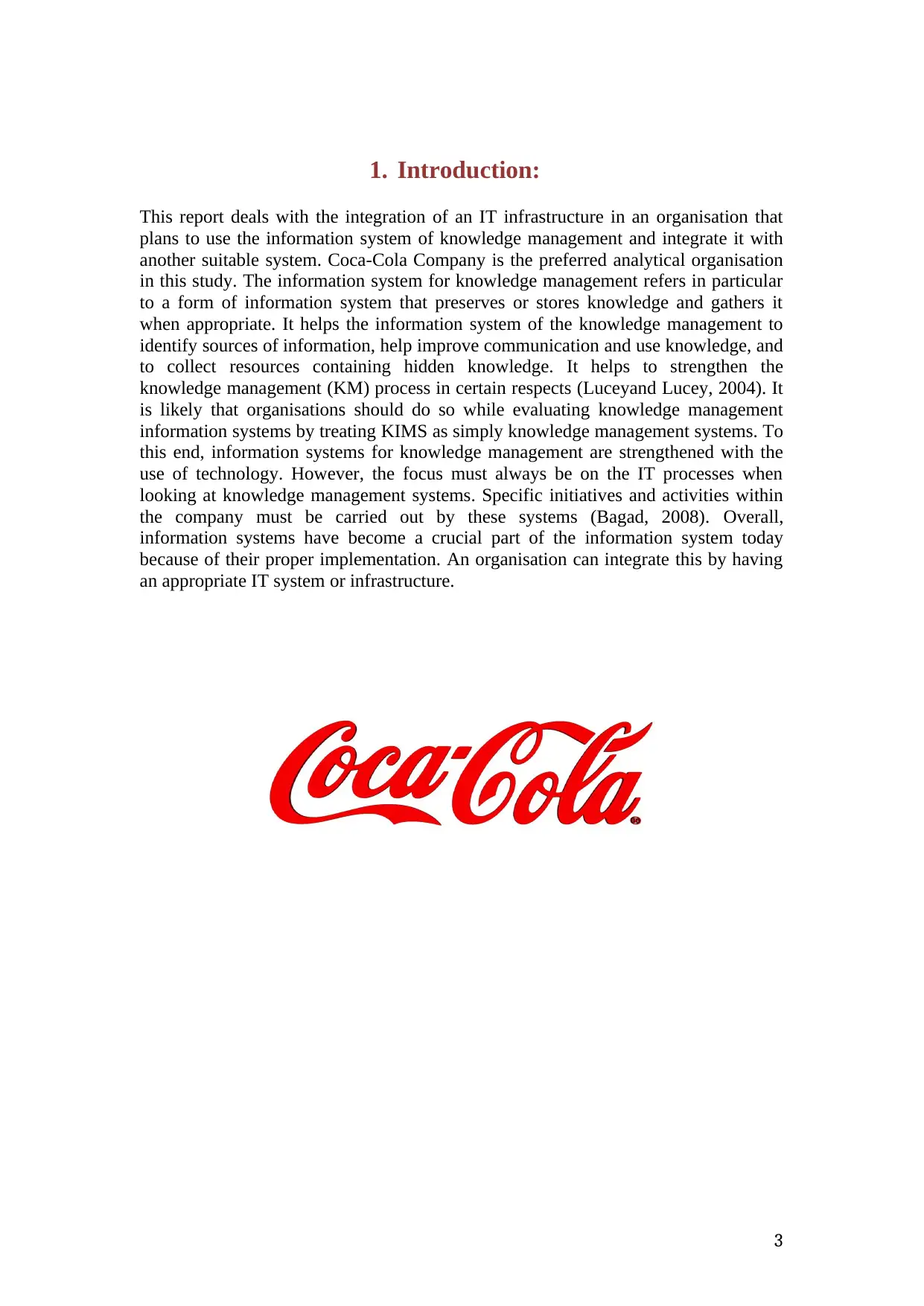
1. Introduction:
This report deals with the integration of an IT infrastructure in an organisation that
plans to use the information system of knowledge management and integrate it with
another suitable system. Coca-Cola Company is the preferred analytical organisation
in this study. The information system for knowledge management refers in particular
to a form of information system that preserves or stores knowledge and gathers it
when appropriate. It helps the information system of the knowledge management to
identify sources of information, help improve communication and use knowledge, and
to collect resources containing hidden knowledge. It helps to strengthen the
knowledge management (KM) process in certain respects (Luceyand Lucey, 2004). It
is likely that organisations should do so while evaluating knowledge management
information systems by treating KIMS as simply knowledge management systems. To
this end, information systems for knowledge management are strengthened with the
use of technology. However, the focus must always be on the IT processes when
looking at knowledge management systems. Specific initiatives and activities within
the company must be carried out by these systems (Bagad, 2008). Overall,
information systems have become a crucial part of the information system today
because of their proper implementation. An organisation can integrate this by having
an appropriate IT system or infrastructure.
3
This report deals with the integration of an IT infrastructure in an organisation that
plans to use the information system of knowledge management and integrate it with
another suitable system. Coca-Cola Company is the preferred analytical organisation
in this study. The information system for knowledge management refers in particular
to a form of information system that preserves or stores knowledge and gathers it
when appropriate. It helps the information system of the knowledge management to
identify sources of information, help improve communication and use knowledge, and
to collect resources containing hidden knowledge. It helps to strengthen the
knowledge management (KM) process in certain respects (Luceyand Lucey, 2004). It
is likely that organisations should do so while evaluating knowledge management
information systems by treating KIMS as simply knowledge management systems. To
this end, information systems for knowledge management are strengthened with the
use of technology. However, the focus must always be on the IT processes when
looking at knowledge management systems. Specific initiatives and activities within
the company must be carried out by these systems (Bagad, 2008). Overall,
information systems have become a crucial part of the information system today
because of their proper implementation. An organisation can integrate this by having
an appropriate IT system or infrastructure.
3
⊘ This is a preview!⊘
Do you want full access?
Subscribe today to unlock all pages.

Trusted by 1+ million students worldwide
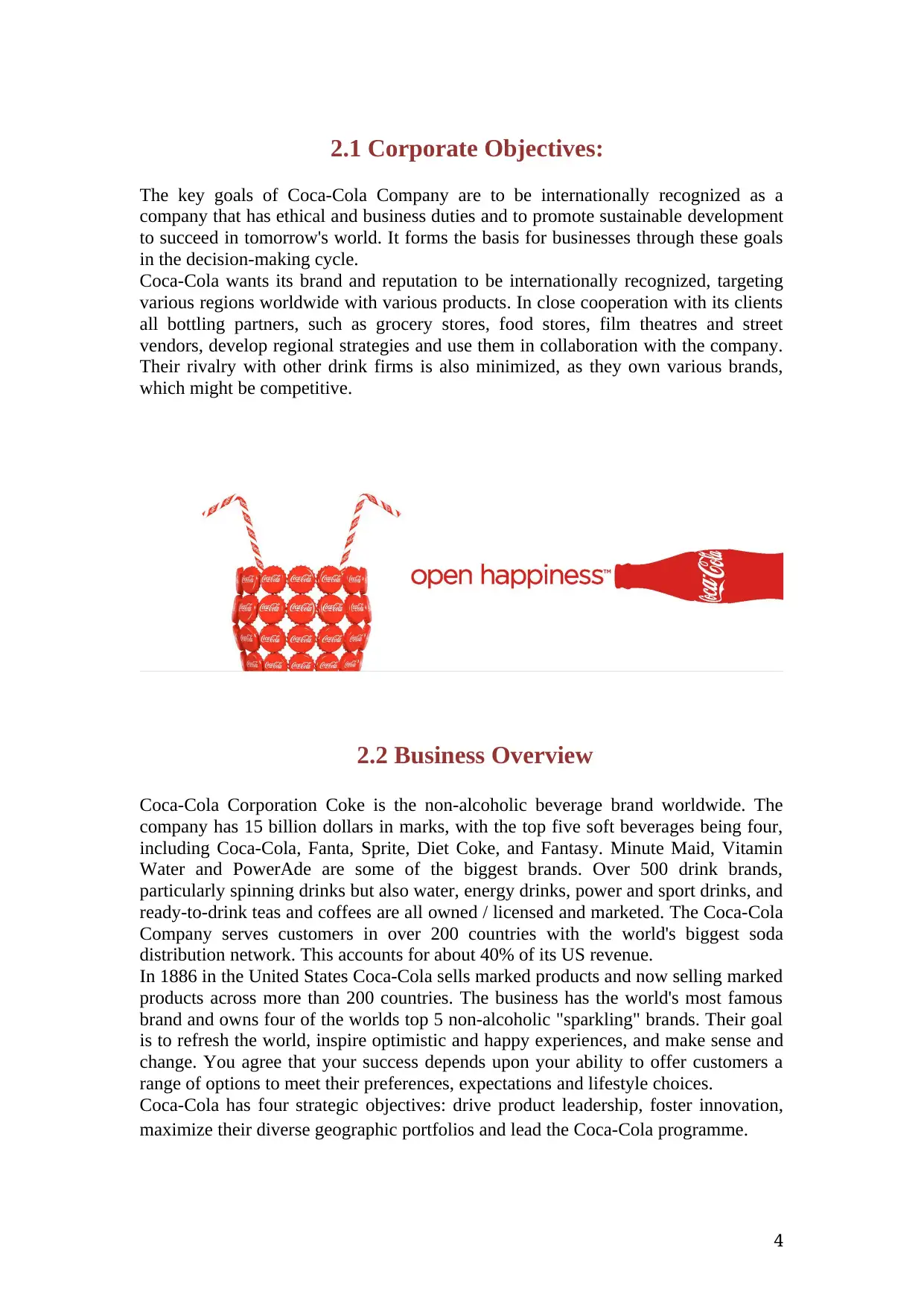
2.1 Corporate Objectives:
The key goals of Coca-Cola Company are to be internationally recognized as a
company that has ethical and business duties and to promote sustainable development
to succeed in tomorrow's world. It forms the basis for businesses through these goals
in the decision-making cycle.
Coca-Cola wants its brand and reputation to be internationally recognized, targeting
various regions worldwide with various products. In close cooperation with its clients
all bottling partners, such as grocery stores, food stores, film theatres and street
vendors, develop regional strategies and use them in collaboration with the company.
Their rivalry with other drink firms is also minimized, as they own various brands,
which might be competitive.
2.2 Business Overview
Coca-Cola Corporation Coke is the non-alcoholic beverage brand worldwide. The
company has 15 billion dollars in marks, with the top five soft beverages being four,
including Coca-Cola, Fanta, Sprite, Diet Coke, and Fantasy. Minute Maid, Vitamin
Water and PowerAde are some of the biggest brands. Over 500 drink brands,
particularly spinning drinks but also water, energy drinks, power and sport drinks, and
ready-to-drink teas and coffees are all owned / licensed and marketed. The Coca-Cola
Company serves customers in over 200 countries with the world's biggest soda
distribution network. This accounts for about 40% of its US revenue.
In 1886 in the United States Coca-Cola sells marked products and now selling marked
products across more than 200 countries. The business has the world's most famous
brand and owns four of the worlds top 5 non-alcoholic "sparkling" brands. Their goal
is to refresh the world, inspire optimistic and happy experiences, and make sense and
change. You agree that your success depends upon your ability to offer customers a
range of options to meet their preferences, expectations and lifestyle choices.
Coca-Cola has four strategic objectives: drive product leadership, foster innovation,
maximize their diverse geographic portfolios and lead the Coca-Cola programme.
4
The key goals of Coca-Cola Company are to be internationally recognized as a
company that has ethical and business duties and to promote sustainable development
to succeed in tomorrow's world. It forms the basis for businesses through these goals
in the decision-making cycle.
Coca-Cola wants its brand and reputation to be internationally recognized, targeting
various regions worldwide with various products. In close cooperation with its clients
all bottling partners, such as grocery stores, food stores, film theatres and street
vendors, develop regional strategies and use them in collaboration with the company.
Their rivalry with other drink firms is also minimized, as they own various brands,
which might be competitive.
2.2 Business Overview
Coca-Cola Corporation Coke is the non-alcoholic beverage brand worldwide. The
company has 15 billion dollars in marks, with the top five soft beverages being four,
including Coca-Cola, Fanta, Sprite, Diet Coke, and Fantasy. Minute Maid, Vitamin
Water and PowerAde are some of the biggest brands. Over 500 drink brands,
particularly spinning drinks but also water, energy drinks, power and sport drinks, and
ready-to-drink teas and coffees are all owned / licensed and marketed. The Coca-Cola
Company serves customers in over 200 countries with the world's biggest soda
distribution network. This accounts for about 40% of its US revenue.
In 1886 in the United States Coca-Cola sells marked products and now selling marked
products across more than 200 countries. The business has the world's most famous
brand and owns four of the worlds top 5 non-alcoholic "sparkling" brands. Their goal
is to refresh the world, inspire optimistic and happy experiences, and make sense and
change. You agree that your success depends upon your ability to offer customers a
range of options to meet their preferences, expectations and lifestyle choices.
Coca-Cola has four strategic objectives: drive product leadership, foster innovation,
maximize their diverse geographic portfolios and lead the Coca-Cola programme.
4
Paraphrase This Document
Need a fresh take? Get an instant paraphrase of this document with our AI Paraphraser
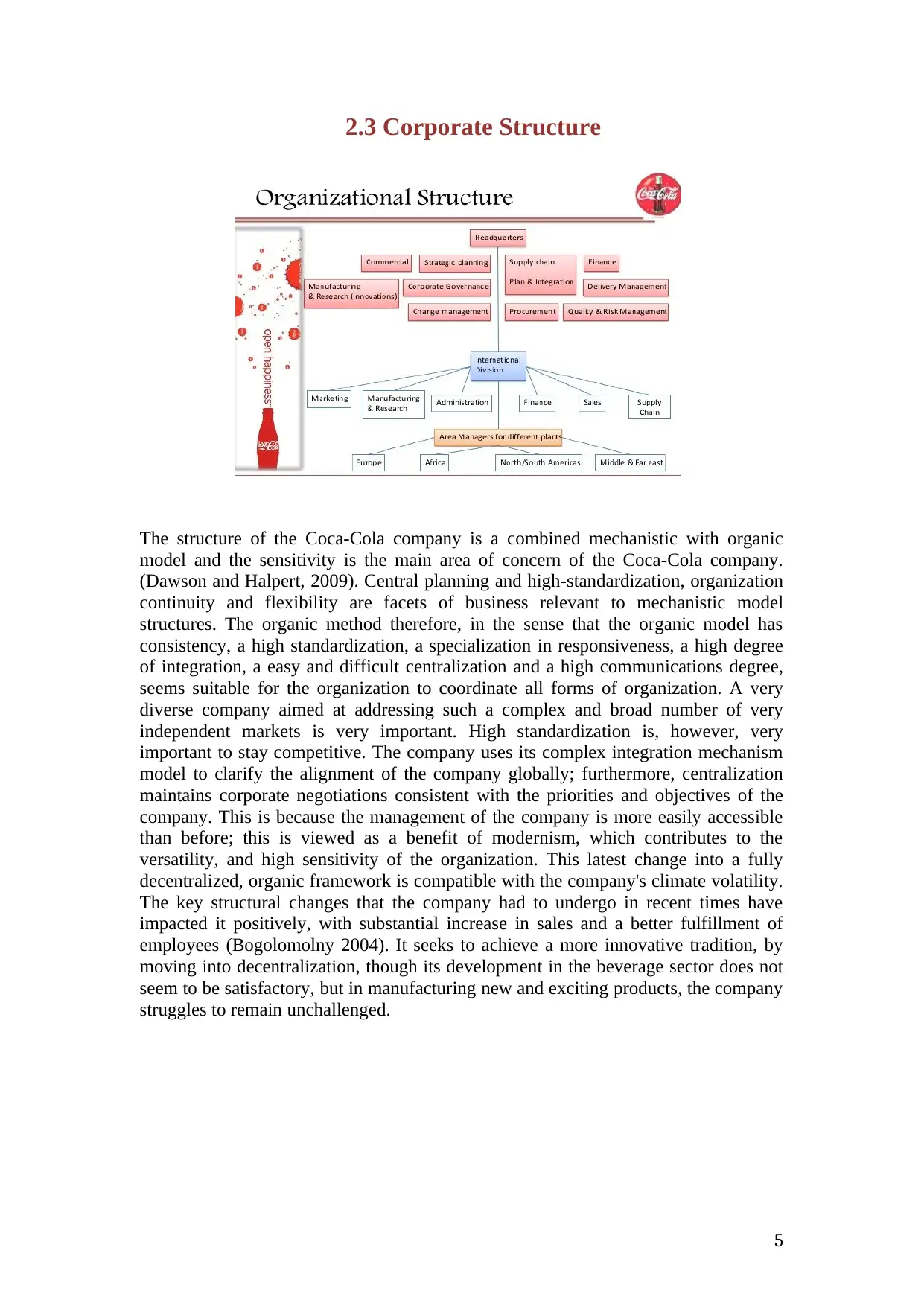
2.3 Corporate Structure
The structure of the Coca-Cola company is a combined mechanistic with organic
model and the sensitivity is the main area of concern of the Coca-Cola company.
(Dawson and Halpert, 2009). Central planning and high-standardization, organization
continuity and flexibility are facets of business relevant to mechanistic model
structures. The organic method therefore, in the sense that the organic model has
consistency, a high standardization, a specialization in responsiveness, a high degree
of integration, a easy and difficult centralization and a high communications degree,
seems suitable for the organization to coordinate all forms of organization. A very
diverse company aimed at addressing such a complex and broad number of very
independent markets is very important. High standardization is, however, very
important to stay competitive. The company uses its complex integration mechanism
model to clarify the alignment of the company globally; furthermore, centralization
maintains corporate negotiations consistent with the priorities and objectives of the
company. This is because the management of the company is more easily accessible
than before; this is viewed as a benefit of modernism, which contributes to the
versatility, and high sensitivity of the organization. This latest change into a fully
decentralized, organic framework is compatible with the company's climate volatility.
The key structural changes that the company had to undergo in recent times have
impacted it positively, with substantial increase in sales and a better fulfillment of
employees (Bogolomolny 2004). It seeks to achieve a more innovative tradition, by
moving into decentralization, though its development in the beverage sector does not
seem to be satisfactory, but in manufacturing new and exciting products, the company
struggles to remain unchallenged.
5
The structure of the Coca-Cola company is a combined mechanistic with organic
model and the sensitivity is the main area of concern of the Coca-Cola company.
(Dawson and Halpert, 2009). Central planning and high-standardization, organization
continuity and flexibility are facets of business relevant to mechanistic model
structures. The organic method therefore, in the sense that the organic model has
consistency, a high standardization, a specialization in responsiveness, a high degree
of integration, a easy and difficult centralization and a high communications degree,
seems suitable for the organization to coordinate all forms of organization. A very
diverse company aimed at addressing such a complex and broad number of very
independent markets is very important. High standardization is, however, very
important to stay competitive. The company uses its complex integration mechanism
model to clarify the alignment of the company globally; furthermore, centralization
maintains corporate negotiations consistent with the priorities and objectives of the
company. This is because the management of the company is more easily accessible
than before; this is viewed as a benefit of modernism, which contributes to the
versatility, and high sensitivity of the organization. This latest change into a fully
decentralized, organic framework is compatible with the company's climate volatility.
The key structural changes that the company had to undergo in recent times have
impacted it positively, with substantial increase in sales and a better fulfillment of
employees (Bogolomolny 2004). It seeks to achieve a more innovative tradition, by
moving into decentralization, though its development in the beverage sector does not
seem to be satisfactory, but in manufacturing new and exciting products, the company
struggles to remain unchallenged.
5
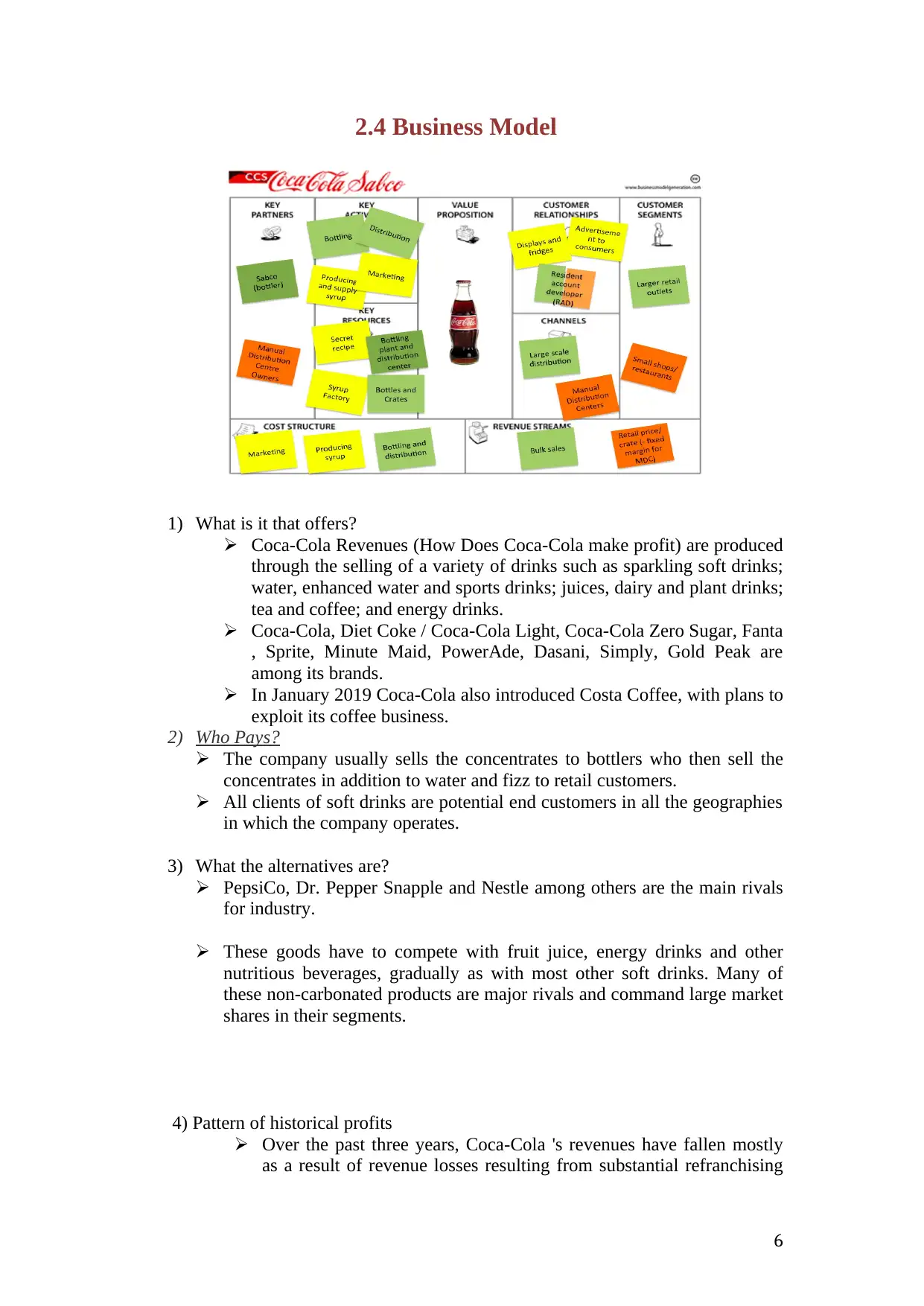
2.4 Business Model
1) What is it that offers?
Coca-Cola Revenues (How Does Coca-Cola make profit) are produced
through the selling of a variety of drinks such as sparkling soft drinks;
water, enhanced water and sports drinks; juices, dairy and plant drinks;
tea and coffee; and energy drinks.
Coca-Cola, Diet Coke / Coca-Cola Light, Coca-Cola Zero Sugar, Fanta
, Sprite, Minute Maid, PowerAde, Dasani, Simply, Gold Peak are
among its brands.
In January 2019 Coca-Cola also introduced Costa Coffee, with plans to
exploit its coffee business.
2) Who Pays?
The company usually sells the concentrates to bottlers who then sell the
concentrates in addition to water and fizz to retail customers.
All clients of soft drinks are potential end customers in all the geographies
in which the company operates.
3) What the alternatives are?
PepsiCo, Dr. Pepper Snapple and Nestle among others are the main rivals
for industry.
These goods have to compete with fruit juice, energy drinks and other
nutritious beverages, gradually as with most other soft drinks. Many of
these non-carbonated products are major rivals and command large market
shares in their segments.
4) Pattern of historical profits
Over the past three years, Coca-Cola 's revenues have fallen mostly
as a result of revenue losses resulting from substantial refranchising
6
1) What is it that offers?
Coca-Cola Revenues (How Does Coca-Cola make profit) are produced
through the selling of a variety of drinks such as sparkling soft drinks;
water, enhanced water and sports drinks; juices, dairy and plant drinks;
tea and coffee; and energy drinks.
Coca-Cola, Diet Coke / Coca-Cola Light, Coca-Cola Zero Sugar, Fanta
, Sprite, Minute Maid, PowerAde, Dasani, Simply, Gold Peak are
among its brands.
In January 2019 Coca-Cola also introduced Costa Coffee, with plans to
exploit its coffee business.
2) Who Pays?
The company usually sells the concentrates to bottlers who then sell the
concentrates in addition to water and fizz to retail customers.
All clients of soft drinks are potential end customers in all the geographies
in which the company operates.
3) What the alternatives are?
PepsiCo, Dr. Pepper Snapple and Nestle among others are the main rivals
for industry.
These goods have to compete with fruit juice, energy drinks and other
nutritious beverages, gradually as with most other soft drinks. Many of
these non-carbonated products are major rivals and command large market
shares in their segments.
4) Pattern of historical profits
Over the past three years, Coca-Cola 's revenues have fallen mostly
as a result of revenue losses resulting from substantial refranchising
6
⊘ This is a preview!⊘
Do you want full access?
Subscribe today to unlock all pages.

Trusted by 1+ million students worldwide
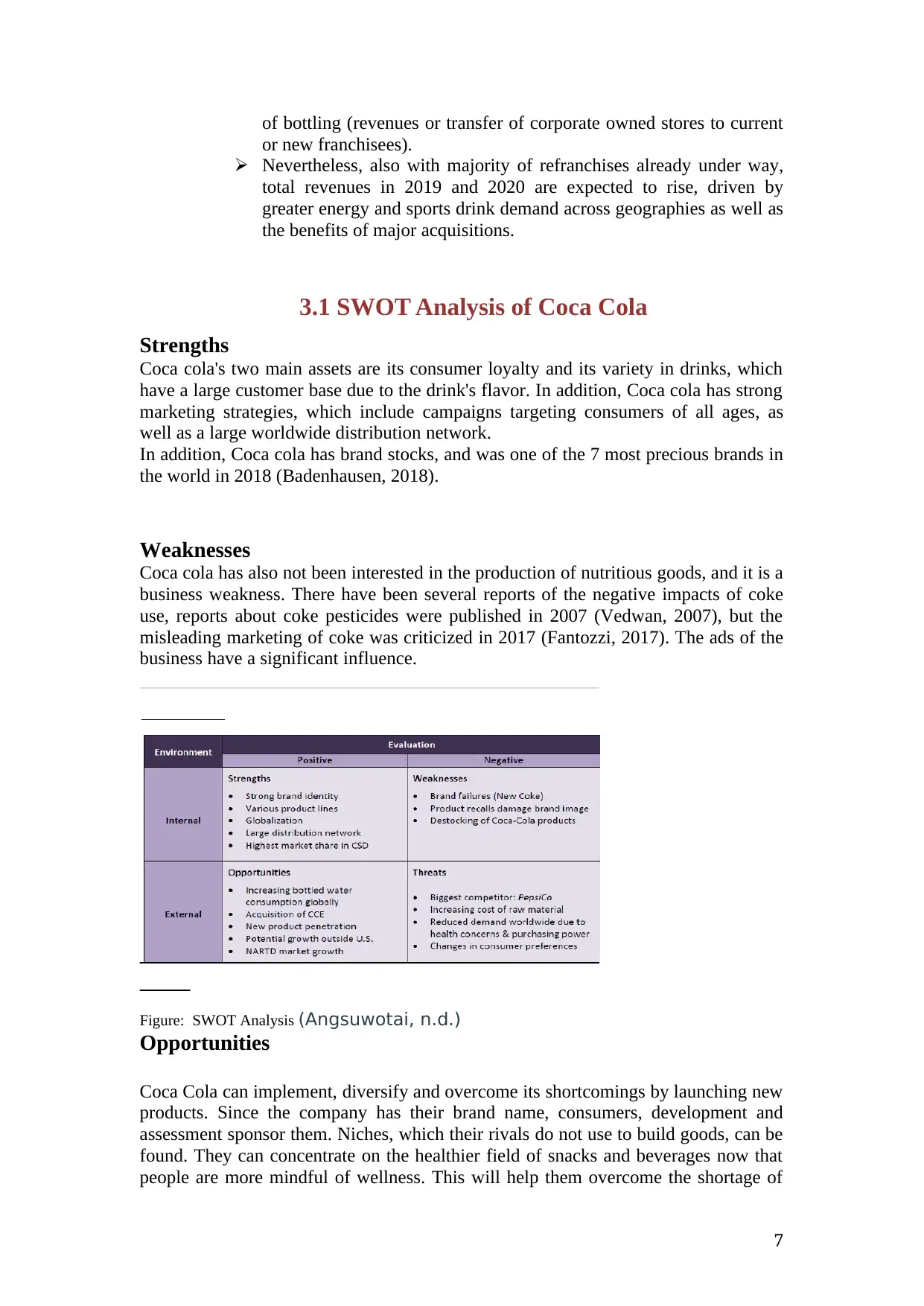
of bottling (revenues or transfer of corporate owned stores to current
or new franchisees).
Nevertheless, also with majority of refranchises already under way,
total revenues in 2019 and 2020 are expected to rise, driven by
greater energy and sports drink demand across geographies as well as
the benefits of major acquisitions.
3.1 SWOT Analysis of Coca Cola
Strengths
Coca cola's two main assets are its consumer loyalty and its variety in drinks, which
have a large customer base due to the drink's flavor. In addition, Coca cola has strong
marketing strategies, which include campaigns targeting consumers of all ages, as
well as a large worldwide distribution network.
In addition, Coca cola has brand stocks, and was one of the 7 most precious brands in
the world in 2018 (Badenhausen, 2018).
Weaknesses
Coca cola has also not been interested in the production of nutritious goods, and it is a
business weakness. There have been several reports of the negative impacts of coke
use, reports about coke pesticides were published in 2007 (Vedwan, 2007), but the
misleading marketing of coke was criticized in 2017 (Fantozzi, 2017). The ads of the
business have a significant influence.
Figure: SWOT Analysis (Angsuwotai, n.d.)
Opportunities
Coca Cola can implement, diversify and overcome its shortcomings by launching new
products. Since the company has their brand name, consumers, development and
assessment sponsor them. Niches, which their rivals do not use to build goods, can be
found. They can concentrate on the healthier field of snacks and beverages now that
people are more mindful of wellness. This will help them overcome the shortage of
7
or new franchisees).
Nevertheless, also with majority of refranchises already under way,
total revenues in 2019 and 2020 are expected to rise, driven by
greater energy and sports drink demand across geographies as well as
the benefits of major acquisitions.
3.1 SWOT Analysis of Coca Cola
Strengths
Coca cola's two main assets are its consumer loyalty and its variety in drinks, which
have a large customer base due to the drink's flavor. In addition, Coca cola has strong
marketing strategies, which include campaigns targeting consumers of all ages, as
well as a large worldwide distribution network.
In addition, Coca cola has brand stocks, and was one of the 7 most precious brands in
the world in 2018 (Badenhausen, 2018).
Weaknesses
Coca cola has also not been interested in the production of nutritious goods, and it is a
business weakness. There have been several reports of the negative impacts of coke
use, reports about coke pesticides were published in 2007 (Vedwan, 2007), but the
misleading marketing of coke was criticized in 2017 (Fantozzi, 2017). The ads of the
business have a significant influence.
Figure: SWOT Analysis (Angsuwotai, n.d.)
Opportunities
Coca Cola can implement, diversify and overcome its shortcomings by launching new
products. Since the company has their brand name, consumers, development and
assessment sponsor them. Niches, which their rivals do not use to build goods, can be
found. They can concentrate on the healthier field of snacks and beverages now that
people are more mindful of wellness. This will help them overcome the shortage of
7
Paraphrase This Document
Need a fresh take? Get an instant paraphrase of this document with our AI Paraphraser
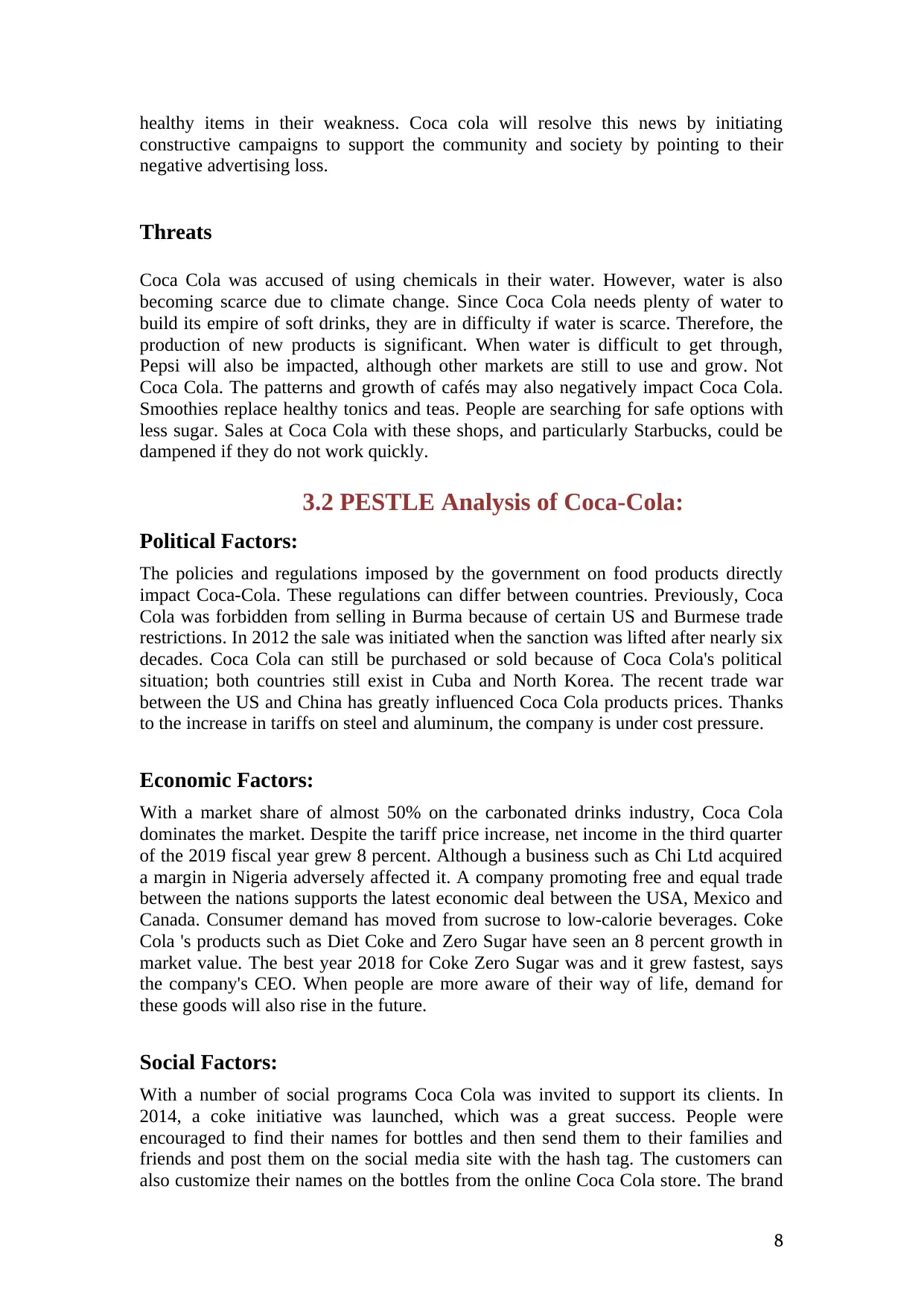
healthy items in their weakness. Coca cola will resolve this news by initiating
constructive campaigns to support the community and society by pointing to their
negative advertising loss.
Threats
Coca Cola was accused of using chemicals in their water. However, water is also
becoming scarce due to climate change. Since Coca Cola needs plenty of water to
build its empire of soft drinks, they are in difficulty if water is scarce. Therefore, the
production of new products is significant. When water is difficult to get through,
Pepsi will also be impacted, although other markets are still to use and grow. Not
Coca Cola. The patterns and growth of cafés may also negatively impact Coca Cola.
Smoothies replace healthy tonics and teas. People are searching for safe options with
less sugar. Sales at Coca Cola with these shops, and particularly Starbucks, could be
dampened if they do not work quickly.
3.2 PESTLE Analysis of Coca-Cola:
Political Factors:
The policies and regulations imposed by the government on food products directly
impact Coca-Cola. These regulations can differ between countries. Previously, Coca
Cola was forbidden from selling in Burma because of certain US and Burmese trade
restrictions. In 2012 the sale was initiated when the sanction was lifted after nearly six
decades. Coca Cola can still be purchased or sold because of Coca Cola's political
situation; both countries still exist in Cuba and North Korea. The recent trade war
between the US and China has greatly influenced Coca Cola products prices. Thanks
to the increase in tariffs on steel and aluminum, the company is under cost pressure.
Economic Factors:
With a market share of almost 50% on the carbonated drinks industry, Coca Cola
dominates the market. Despite the tariff price increase, net income in the third quarter
of the 2019 fiscal year grew 8 percent. Although a business such as Chi Ltd acquired
a margin in Nigeria adversely affected it. A company promoting free and equal trade
between the nations supports the latest economic deal between the USA, Mexico and
Canada. Consumer demand has moved from sucrose to low-calorie beverages. Coke
Cola 's products such as Diet Coke and Zero Sugar have seen an 8 percent growth in
market value. The best year 2018 for Coke Zero Sugar was and it grew fastest, says
the company's CEO. When people are more aware of their way of life, demand for
these goods will also rise in the future.
Social Factors:
With a number of social programs Coca Cola was invited to support its clients. In
2014, a coke initiative was launched, which was a great success. People were
encouraged to find their names for bottles and then send them to their families and
friends and post them on the social media site with the hash tag. The customers can
also customize their names on the bottles from the online Coca Cola store. The brand
8
constructive campaigns to support the community and society by pointing to their
negative advertising loss.
Threats
Coca Cola was accused of using chemicals in their water. However, water is also
becoming scarce due to climate change. Since Coca Cola needs plenty of water to
build its empire of soft drinks, they are in difficulty if water is scarce. Therefore, the
production of new products is significant. When water is difficult to get through,
Pepsi will also be impacted, although other markets are still to use and grow. Not
Coca Cola. The patterns and growth of cafés may also negatively impact Coca Cola.
Smoothies replace healthy tonics and teas. People are searching for safe options with
less sugar. Sales at Coca Cola with these shops, and particularly Starbucks, could be
dampened if they do not work quickly.
3.2 PESTLE Analysis of Coca-Cola:
Political Factors:
The policies and regulations imposed by the government on food products directly
impact Coca-Cola. These regulations can differ between countries. Previously, Coca
Cola was forbidden from selling in Burma because of certain US and Burmese trade
restrictions. In 2012 the sale was initiated when the sanction was lifted after nearly six
decades. Coca Cola can still be purchased or sold because of Coca Cola's political
situation; both countries still exist in Cuba and North Korea. The recent trade war
between the US and China has greatly influenced Coca Cola products prices. Thanks
to the increase in tariffs on steel and aluminum, the company is under cost pressure.
Economic Factors:
With a market share of almost 50% on the carbonated drinks industry, Coca Cola
dominates the market. Despite the tariff price increase, net income in the third quarter
of the 2019 fiscal year grew 8 percent. Although a business such as Chi Ltd acquired
a margin in Nigeria adversely affected it. A company promoting free and equal trade
between the nations supports the latest economic deal between the USA, Mexico and
Canada. Consumer demand has moved from sucrose to low-calorie beverages. Coke
Cola 's products such as Diet Coke and Zero Sugar have seen an 8 percent growth in
market value. The best year 2018 for Coke Zero Sugar was and it grew fastest, says
the company's CEO. When people are more aware of their way of life, demand for
these goods will also rise in the future.
Social Factors:
With a number of social programs Coca Cola was invited to support its clients. In
2014, a coke initiative was launched, which was a great success. People were
encouraged to find their names for bottles and then send them to their families and
friends and post them on the social media site with the hash tag. The customers can
also customize their names on the bottles from the online Coca Cola store. The brand
8
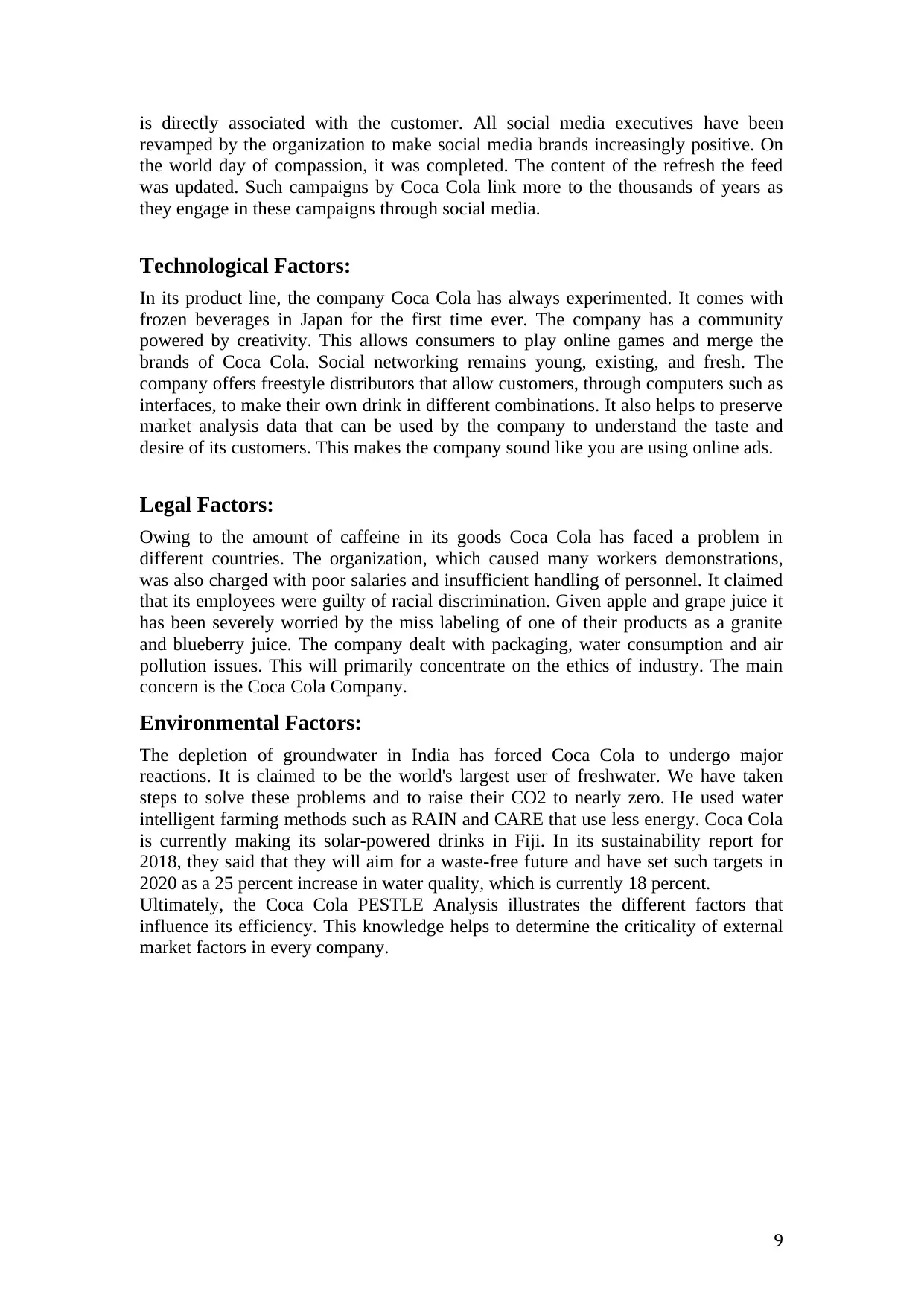
is directly associated with the customer. All social media executives have been
revamped by the organization to make social media brands increasingly positive. On
the world day of compassion, it was completed. The content of the refresh the feed
was updated. Such campaigns by Coca Cola link more to the thousands of years as
they engage in these campaigns through social media.
Technological Factors:
In its product line, the company Coca Cola has always experimented. It comes with
frozen beverages in Japan for the first time ever. The company has a community
powered by creativity. This allows consumers to play online games and merge the
brands of Coca Cola. Social networking remains young, existing, and fresh. The
company offers freestyle distributors that allow customers, through computers such as
interfaces, to make their own drink in different combinations. It also helps to preserve
market analysis data that can be used by the company to understand the taste and
desire of its customers. This makes the company sound like you are using online ads.
Legal Factors:
Owing to the amount of caffeine in its goods Coca Cola has faced a problem in
different countries. The organization, which caused many workers demonstrations,
was also charged with poor salaries and insufficient handling of personnel. It claimed
that its employees were guilty of racial discrimination. Given apple and grape juice it
has been severely worried by the miss labeling of one of their products as a granite
and blueberry juice. The company dealt with packaging, water consumption and air
pollution issues. This will primarily concentrate on the ethics of industry. The main
concern is the Coca Cola Company.
Environmental Factors:
The depletion of groundwater in India has forced Coca Cola to undergo major
reactions. It is claimed to be the world's largest user of freshwater. We have taken
steps to solve these problems and to raise their CO2 to nearly zero. He used water
intelligent farming methods such as RAIN and CARE that use less energy. Coca Cola
is currently making its solar-powered drinks in Fiji. In its sustainability report for
2018, they said that they will aim for a waste-free future and have set such targets in
2020 as a 25 percent increase in water quality, which is currently 18 percent.
Ultimately, the Coca Cola PESTLE Analysis illustrates the different factors that
influence its efficiency. This knowledge helps to determine the criticality of external
market factors in every company.
9
revamped by the organization to make social media brands increasingly positive. On
the world day of compassion, it was completed. The content of the refresh the feed
was updated. Such campaigns by Coca Cola link more to the thousands of years as
they engage in these campaigns through social media.
Technological Factors:
In its product line, the company Coca Cola has always experimented. It comes with
frozen beverages in Japan for the first time ever. The company has a community
powered by creativity. This allows consumers to play online games and merge the
brands of Coca Cola. Social networking remains young, existing, and fresh. The
company offers freestyle distributors that allow customers, through computers such as
interfaces, to make their own drink in different combinations. It also helps to preserve
market analysis data that can be used by the company to understand the taste and
desire of its customers. This makes the company sound like you are using online ads.
Legal Factors:
Owing to the amount of caffeine in its goods Coca Cola has faced a problem in
different countries. The organization, which caused many workers demonstrations,
was also charged with poor salaries and insufficient handling of personnel. It claimed
that its employees were guilty of racial discrimination. Given apple and grape juice it
has been severely worried by the miss labeling of one of their products as a granite
and blueberry juice. The company dealt with packaging, water consumption and air
pollution issues. This will primarily concentrate on the ethics of industry. The main
concern is the Coca Cola Company.
Environmental Factors:
The depletion of groundwater in India has forced Coca Cola to undergo major
reactions. It is claimed to be the world's largest user of freshwater. We have taken
steps to solve these problems and to raise their CO2 to nearly zero. He used water
intelligent farming methods such as RAIN and CARE that use less energy. Coca Cola
is currently making its solar-powered drinks in Fiji. In its sustainability report for
2018, they said that they will aim for a waste-free future and have set such targets in
2020 as a 25 percent increase in water quality, which is currently 18 percent.
Ultimately, the Coca Cola PESTLE Analysis illustrates the different factors that
influence its efficiency. This knowledge helps to determine the criticality of external
market factors in every company.
9
⊘ This is a preview!⊘
Do you want full access?
Subscribe today to unlock all pages.

Trusted by 1+ million students worldwide
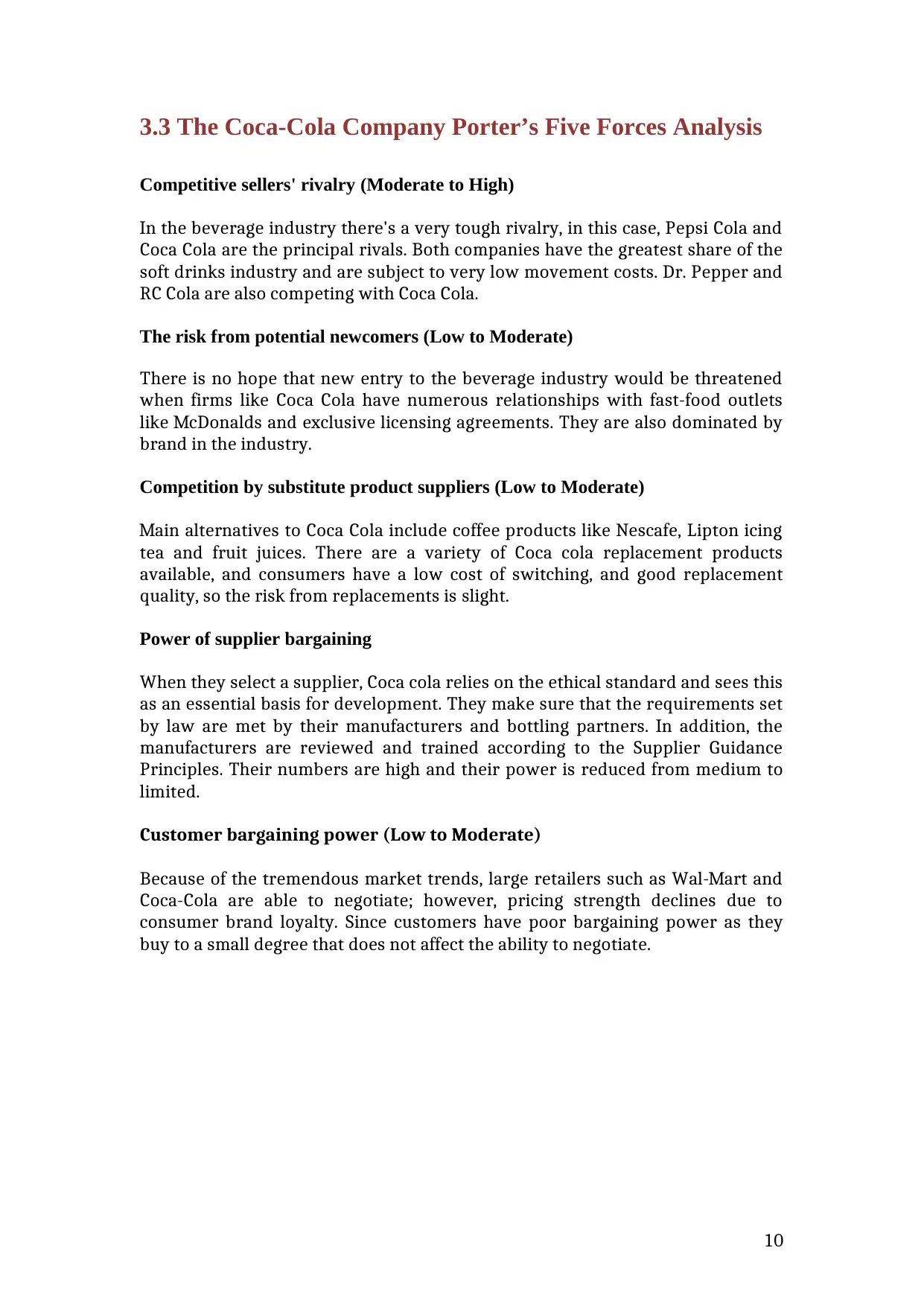
3.3 The Coca-Cola Company Porter’s Five Forces Analysis
Competitive sellers' rivalry (Moderate to High)
In the beverage industry there's a very tough rivalry, in this case, Pepsi Cola and
Coca Cola are the principal rivals. Both companies have the greatest share of the
soft drinks industry and are subject to very low movement costs. Dr. Pepper and
RC Cola are also competing with Coca Cola.
The risk from potential newcomers (Low to Moderate)
There is no hope that new entry to the beverage industry would be threatened
when firms like Coca Cola have numerous relationships with fast-food outlets
like McDonalds and exclusive licensing agreements. They are also dominated by
brand in the industry.
Competition by substitute product suppliers (Low to Moderate)
Main alternatives to Coca Cola include coffee products like Nescafe, Lipton icing
tea and fruit juices. There are a variety of Coca cola replacement products
available, and consumers have a low cost of switching, and good replacement
quality, so the risk from replacements is slight.
Power of supplier bargaining
When they select a supplier, Coca cola relies on the ethical standard and sees this
as an essential basis for development. They make sure that the requirements set
by law are met by their manufacturers and bottling partners. In addition, the
manufacturers are reviewed and trained according to the Supplier Guidance
Principles. Their numbers are high and their power is reduced from medium to
limited.
Customer bargaining power (Low to Moderate)
Because of the tremendous market trends, large retailers such as Wal-Mart and
Coca-Cola are able to negotiate; however, pricing strength declines due to
consumer brand loyalty. Since customers have poor bargaining power as they
buy to a small degree that does not affect the ability to negotiate.
10
Competitive sellers' rivalry (Moderate to High)
In the beverage industry there's a very tough rivalry, in this case, Pepsi Cola and
Coca Cola are the principal rivals. Both companies have the greatest share of the
soft drinks industry and are subject to very low movement costs. Dr. Pepper and
RC Cola are also competing with Coca Cola.
The risk from potential newcomers (Low to Moderate)
There is no hope that new entry to the beverage industry would be threatened
when firms like Coca Cola have numerous relationships with fast-food outlets
like McDonalds and exclusive licensing agreements. They are also dominated by
brand in the industry.
Competition by substitute product suppliers (Low to Moderate)
Main alternatives to Coca Cola include coffee products like Nescafe, Lipton icing
tea and fruit juices. There are a variety of Coca cola replacement products
available, and consumers have a low cost of switching, and good replacement
quality, so the risk from replacements is slight.
Power of supplier bargaining
When they select a supplier, Coca cola relies on the ethical standard and sees this
as an essential basis for development. They make sure that the requirements set
by law are met by their manufacturers and bottling partners. In addition, the
manufacturers are reviewed and trained according to the Supplier Guidance
Principles. Their numbers are high and their power is reduced from medium to
limited.
Customer bargaining power (Low to Moderate)
Because of the tremendous market trends, large retailers such as Wal-Mart and
Coca-Cola are able to negotiate; however, pricing strength declines due to
consumer brand loyalty. Since customers have poor bargaining power as they
buy to a small degree that does not affect the ability to negotiate.
10
Paraphrase This Document
Need a fresh take? Get an instant paraphrase of this document with our AI Paraphraser
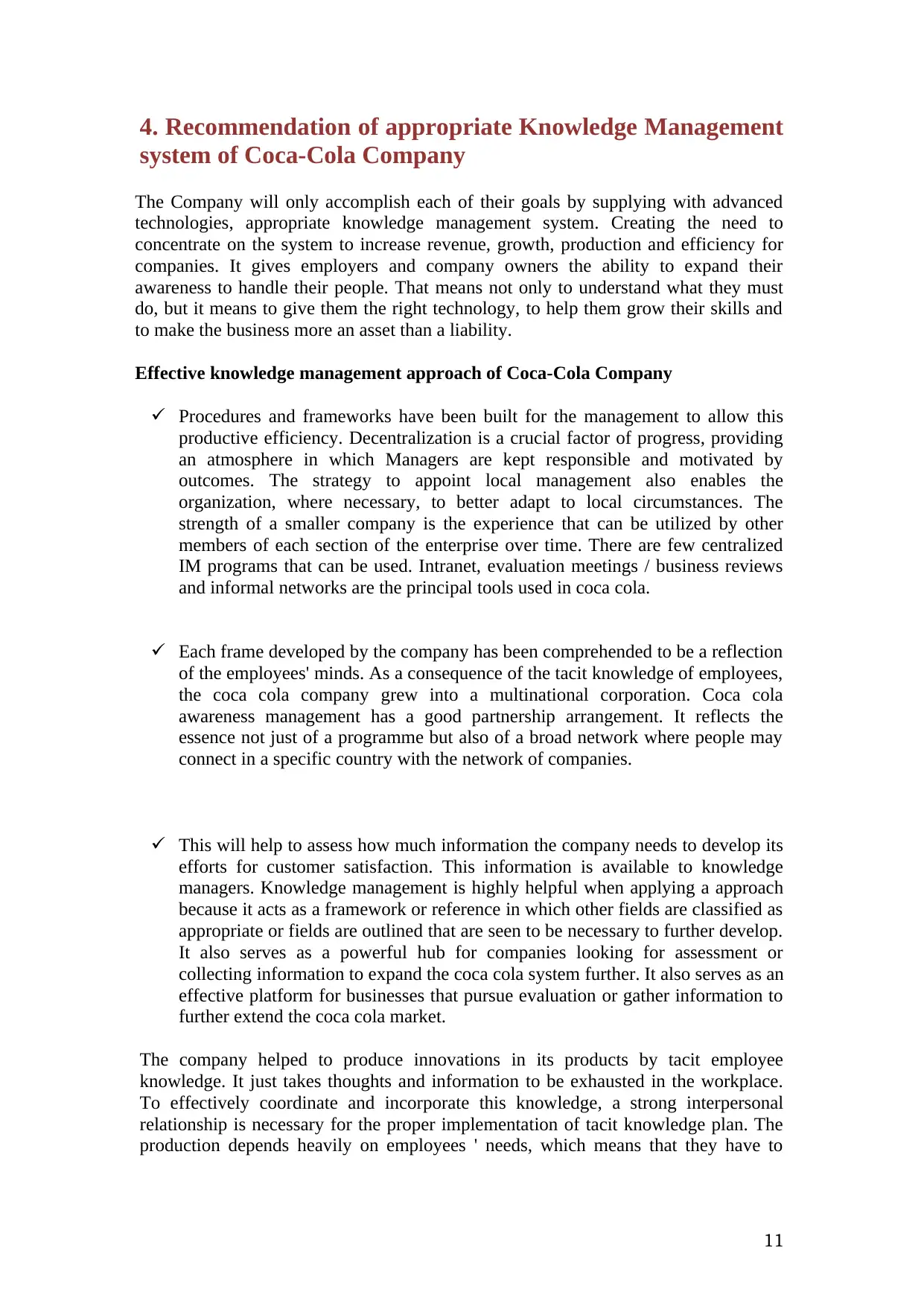
4. Recommendation of appropriate Knowledge Management
system of Coca-Cola Company
The Company will only accomplish each of their goals by supplying with advanced
technologies, appropriate knowledge management system. Creating the need to
concentrate on the system to increase revenue, growth, production and efficiency for
companies. It gives employers and company owners the ability to expand their
awareness to handle their people. That means not only to understand what they must
do, but it means to give them the right technology, to help them grow their skills and
to make the business more an asset than a liability.
Effective knowledge management approach of Coca-Cola Company
Procedures and frameworks have been built for the management to allow this
productive efficiency. Decentralization is a crucial factor of progress, providing
an atmosphere in which Managers are kept responsible and motivated by
outcomes. The strategy to appoint local management also enables the
organization, where necessary, to better adapt to local circumstances. The
strength of a smaller company is the experience that can be utilized by other
members of each section of the enterprise over time. There are few centralized
IM programs that can be used. Intranet, evaluation meetings / business reviews
and informal networks are the principal tools used in coca cola.
Each frame developed by the company has been comprehended to be a reflection
of the employees' minds. As a consequence of the tacit knowledge of employees,
the coca cola company grew into a multinational corporation. Coca cola
awareness management has a good partnership arrangement. It reflects the
essence not just of a programme but also of a broad network where people may
connect in a specific country with the network of companies.
This will help to assess how much information the company needs to develop its
efforts for customer satisfaction. This information is available to knowledge
managers. Knowledge management is highly helpful when applying a approach
because it acts as a framework or reference in which other fields are classified as
appropriate or fields are outlined that are seen to be necessary to further develop.
It also serves as a powerful hub for companies looking for assessment or
collecting information to expand the coca cola system further. It also serves as an
effective platform for businesses that pursue evaluation or gather information to
further extend the coca cola market.
The company helped to produce innovations in its products by tacit employee
knowledge. It just takes thoughts and information to be exhausted in the workplace.
To effectively coordinate and incorporate this knowledge, a strong interpersonal
relationship is necessary for the proper implementation of tacit knowledge plan. The
production depends heavily on employees ' needs, which means that they have to
11
system of Coca-Cola Company
The Company will only accomplish each of their goals by supplying with advanced
technologies, appropriate knowledge management system. Creating the need to
concentrate on the system to increase revenue, growth, production and efficiency for
companies. It gives employers and company owners the ability to expand their
awareness to handle their people. That means not only to understand what they must
do, but it means to give them the right technology, to help them grow their skills and
to make the business more an asset than a liability.
Effective knowledge management approach of Coca-Cola Company
Procedures and frameworks have been built for the management to allow this
productive efficiency. Decentralization is a crucial factor of progress, providing
an atmosphere in which Managers are kept responsible and motivated by
outcomes. The strategy to appoint local management also enables the
organization, where necessary, to better adapt to local circumstances. The
strength of a smaller company is the experience that can be utilized by other
members of each section of the enterprise over time. There are few centralized
IM programs that can be used. Intranet, evaluation meetings / business reviews
and informal networks are the principal tools used in coca cola.
Each frame developed by the company has been comprehended to be a reflection
of the employees' minds. As a consequence of the tacit knowledge of employees,
the coca cola company grew into a multinational corporation. Coca cola
awareness management has a good partnership arrangement. It reflects the
essence not just of a programme but also of a broad network where people may
connect in a specific country with the network of companies.
This will help to assess how much information the company needs to develop its
efforts for customer satisfaction. This information is available to knowledge
managers. Knowledge management is highly helpful when applying a approach
because it acts as a framework or reference in which other fields are classified as
appropriate or fields are outlined that are seen to be necessary to further develop.
It also serves as a powerful hub for companies looking for assessment or
collecting information to expand the coca cola system further. It also serves as an
effective platform for businesses that pursue evaluation or gather information to
further extend the coca cola market.
The company helped to produce innovations in its products by tacit employee
knowledge. It just takes thoughts and information to be exhausted in the workplace.
To effectively coordinate and incorporate this knowledge, a strong interpersonal
relationship is necessary for the proper implementation of tacit knowledge plan. The
production depends heavily on employees ' needs, which means that they have to
11
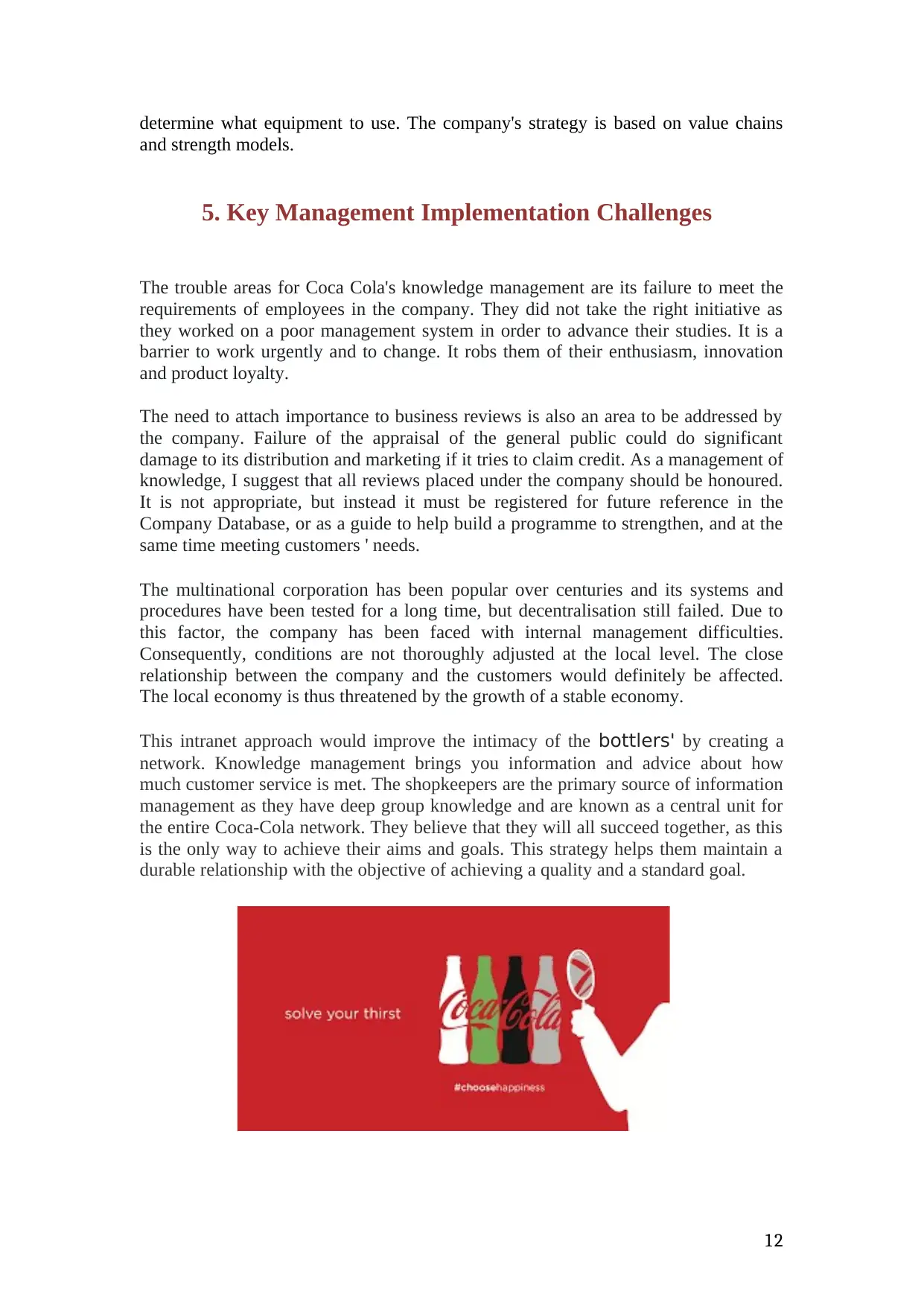
determine what equipment to use. The company's strategy is based on value chains
and strength models.
5. Key Management Implementation Challenges
The trouble areas for Coca Cola's knowledge management are its failure to meet the
requirements of employees in the company. They did not take the right initiative as
they worked on a poor management system in order to advance their studies. It is a
barrier to work urgently and to change. It robs them of their enthusiasm, innovation
and product loyalty.
The need to attach importance to business reviews is also an area to be addressed by
the company. Failure of the appraisal of the general public could do significant
damage to its distribution and marketing if it tries to claim credit. As a management of
knowledge, I suggest that all reviews placed under the company should be honoured.
It is not appropriate, but instead it must be registered for future reference in the
Company Database, or as a guide to help build a programme to strengthen, and at the
same time meeting customers ' needs.
The multinational corporation has been popular over centuries and its systems and
procedures have been tested for a long time, but decentralisation still failed. Due to
this factor, the company has been faced with internal management difficulties.
Consequently, conditions are not thoroughly adjusted at the local level. The close
relationship between the company and the customers would definitely be affected.
The local economy is thus threatened by the growth of a stable economy.
This intranet approach would improve the intimacy of the bottlers' by creating a
network. Knowledge management brings you information and advice about how
much customer service is met. The shopkeepers are the primary source of information
management as they have deep group knowledge and are known as a central unit for
the entire Coca-Cola network. They believe that they will all succeed together, as this
is the only way to achieve their aims and goals. This strategy helps them maintain a
durable relationship with the objective of achieving a quality and a standard goal.
12
and strength models.
5. Key Management Implementation Challenges
The trouble areas for Coca Cola's knowledge management are its failure to meet the
requirements of employees in the company. They did not take the right initiative as
they worked on a poor management system in order to advance their studies. It is a
barrier to work urgently and to change. It robs them of their enthusiasm, innovation
and product loyalty.
The need to attach importance to business reviews is also an area to be addressed by
the company. Failure of the appraisal of the general public could do significant
damage to its distribution and marketing if it tries to claim credit. As a management of
knowledge, I suggest that all reviews placed under the company should be honoured.
It is not appropriate, but instead it must be registered for future reference in the
Company Database, or as a guide to help build a programme to strengthen, and at the
same time meeting customers ' needs.
The multinational corporation has been popular over centuries and its systems and
procedures have been tested for a long time, but decentralisation still failed. Due to
this factor, the company has been faced with internal management difficulties.
Consequently, conditions are not thoroughly adjusted at the local level. The close
relationship between the company and the customers would definitely be affected.
The local economy is thus threatened by the growth of a stable economy.
This intranet approach would improve the intimacy of the bottlers' by creating a
network. Knowledge management brings you information and advice about how
much customer service is met. The shopkeepers are the primary source of information
management as they have deep group knowledge and are known as a central unit for
the entire Coca-Cola network. They believe that they will all succeed together, as this
is the only way to achieve their aims and goals. This strategy helps them maintain a
durable relationship with the objective of achieving a quality and a standard goal.
12
⊘ This is a preview!⊘
Do you want full access?
Subscribe today to unlock all pages.

Trusted by 1+ million students worldwide
1 out of 15
Related Documents
Your All-in-One AI-Powered Toolkit for Academic Success.
+13062052269
info@desklib.com
Available 24*7 on WhatsApp / Email
![[object Object]](/_next/static/media/star-bottom.7253800d.svg)
Unlock your academic potential
Copyright © 2020–2025 A2Z Services. All Rights Reserved. Developed and managed by ZUCOL.





